Primus Mortimer Pettersson
Primus Mortimer Pettersson, Untitled
Signed PMP. Watercolour on paper 31 x 39 cm.
Not examined out of the frame.
Provenance
Sivert Oldenvi Collection
More information
Primus Mortimer Pettersson (1895-1975), also known as "PMP" was one of Sweden's foremost and unique naïve artists. His life was filled with adventure and marked by drama and illness. Through a fortunate encounter with a visionary and innovative medical doctor, his life took an unexpected turn in his 40s from a self-destructive path to a creative one.
Primus was born in Östersund in 1895, but the family soon moved to the nearby picturesque island of Frösön. This would become an important place for the future artist. As a very young man, Primus worked, among other things, as a handyman for his father, who was a tile stove maker. He also received commissions as a decorative painter in Östersund but was unhappy and, at the age of 14, went to sea.
Primus sailed the seven seas, and life at sea took him from ports in Europe to exotic destinations in Africa, South America, South Africa, China, Japan, and the USA. A few preserved postcards provide clues, but it is difficult to chart his life during these years. He could later only recount scattered episodes. Life as a sailor was both perilous and physically challenging, and he often found himself destitute or ill. From a young age, Primus suffered from depression, and at some point during World War I, off the coast of Korea, he experienced delirium and jumped overboard. He was rescued, but around 1923, he was admitted to the psychiatric clinic Stockton Hospital outside San Francisco. There, they were fascinated by the fact that he was tattooed from head to toe. After a few years, which are shrouded in mystery, Primus returned to Sweden and was taken care of by his sister and father. After a few tumultuous years, he was finally declared legally incompetent in 1929 and was admitted to Frösö Hospital, where he remained until his death in 1975.
Primus suffered from troubling obsessive thoughts and was tormented by unpleasant voices and schizophrenia. His divided perception of reality was at the same time a great source of inspiration, and he became stimulated by his deliriums. Encouraged by the chief physician John Agerberg, who was a pioneer in occupational therapy, he began to paint in March 1935. This became a life-changing opportunity that would transform the rest of his life. Every morning, he would arrive at the workshop that had been set up for him. Primus painted approximately 15,000 paintings as a patient at Frösö Hospital.
In Primus's world of motifs, there is a relationship between reason and emotion. He loved houses and combined fragments of memories, dreams, and visions into a wholly imaginative architectural world. The author and art historian Gunnar Hellman writes in a reprint from Jämten in 1975: "Mehmet Aga, the 17th-century architect who designed the exquisite Blue Mosque in Istanbul, would be filled with envy if he had seen Primus's colour-glowing mosques, adorned with domes that not even the boldest sultan would dare to have built."
Primus's paintings are characterised by a glowing colour palette and distinctile light effects. The sky flames in red above arching vaulted constructions. The sea is present, close or in the distance, sometimes glimpsed through a cave-like opening. A solitary boat waits on the shore. Silence dominates in Primus's work; silent landscapes, silent streets where the houses stand close together with darkened windows, and every trace of human life is absent. He often sketched the composition in pencil to finish it in watercolour or oil. When Primus was not painting, he occupied himself with building various boat models and haphazard constructions from leftover materials and scrap.
The first exhibition took place at the Hantverksutställningen in Östersund in 1936. Three decades later, in 1966, his major breakthrough came with the exhibition at the Svensk-Franska konstgalleriet in Stockholm. This was followed by several exhibitions in Sweden and abroad.
Primus Mortimer Pettersson is represented at, among others, Moderna Museet in Stockholm, Norrköping Art Museum, and Kalmar Art Museum. The Jämtland Härjedalen Region still owns about 400 works by Primus Mortimer Pettersson through a donation from his relatives. The works are part of the public art in the region and are displayed in the Primus Room in Östersund, which was created in 2008.











































